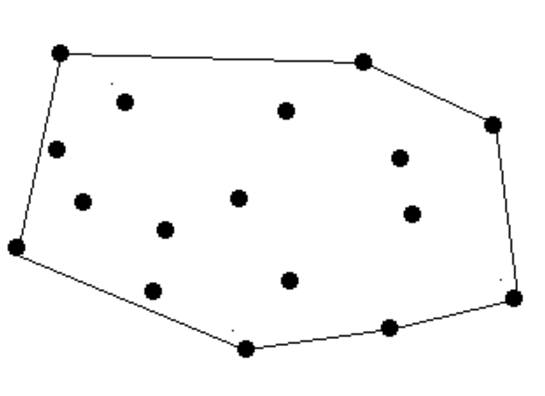Surround the Trees
Time Limit: 2000/1000 MS (Java/Others) Memory Limit: 65536/32768 K (Java/Others)
Total Submission(s): 11811 Accepted Submission(s): 4577
Problem Description
There are a lot of trees in an area. A peasant wants to buy a rope to surround all these trees. So at first he must know the minimal required length of the rope. However, he does not know how to calculate it. Can you help him?
The diameter and length of the trees are omitted, which means a tree can be seen as a point. The thickness of the rope is also omitted which means a rope can be seen as a line.

There are no more than 100 trees.
Input
The input contains one or more data sets. At first line of each input data set is number of trees in this data set, it is followed by series of coordinates of the trees. Each coordinate is a positive integer pair, and each integer is less than 32767. Each pair is separated by blank.
Zero at line for number of trees terminates the input for your program.
Output
The minimal length of the rope. The precision should be 10^-2.
Sample Input
Sample Output

#include <stdio.h> #include <string.h> #include <stdlib.h> #include <math.h> #include <algorithm> //#include <algorithm> namespace Geometry { class point { public: double x, y; point() {} point(const point &p): x(p.x), y(p.y) {} point(double a, double b): x(a), y(b) {} point operator + (const point & p)const { point ret; ret.x = x + p.x, ret.y = y + p.y; return ret; } point operator - (const point & p)const { point ret; ret.x = x - p.x, ret.y = y - p.y; return ret; } //dot product double operator * (const point & p)const { return x * p.x + y * p.y; } //cross product double operator ^ (const point & p)const { return x * p.y - p.x * y; } bool operator < (const point & p)const { if (fabs(x - p.x) < 1e-8) { return y < p.y; } return x < p.x; } double mold() { return sqrt(x * x + y * y); } }; double cp(point a, point b, point o) { return (a - o) ^ (b - o); } class line { public: point A, B; line() {} line(point a, point b): A(a), B(b) {} bool IsLineCrossed(const line &l)const { point v1, v2; double c1, c2; v1 = B - A, v2 = l.A - A; c1 = v1 ^ v2; v2 = l.B - A; c2 = v1 ^ v2; if (c1 * c2 >= 0) { return false; } v1 = l.B - l.A, v2 = A - l.A; c1 = v1 ^ v2; v2 = B - l.A; c2 = v1 ^ v2; if (c1 * c2 >= 0) { return false; } return true; } }; int Graham(point * p, point * s, int n) { std::sort(p, p + n); int top, m; s[0] = p[0]; s[1] = p[1]; top = 1; for (int i = 2; i < n; i++) { //从前往后扫 while (top > 0 && cp(p[i], s[top], s[top - 1]) >= 0) { top--; } s[++top] = p[i]; } m = top; s[++top] = p[n - 2]; for (int i = n - 3; i >= 0; i--) { //从后往前扫 while (top > m && cp(p[i], s[top], s[top - 1]) >= 0) { top--; } s[++top] = p[i]; } return top; } } //using namespace Geometry; using namespace Geometry; point p[200], s[200]; int main() { #ifndef ONLINE_JUDGE freopen("input.txt", "r", stdin); #endif int n; while (scanf("%d", &n) != EOF) { if (n == 0) { break; } for (int i = 0; i < n; i++) { scanf("%lf%lf", &p[i].x, &p[i].y); } int cnt = 0; for (int i = 1; i < n; i++) //去掉重复的点 if (fabs(p[i].x - p[cnt].x) > 1e-8 || fabs(p[i].y - p[cnt].y) > 1e-8) { p[++cnt] = p[i]; } cnt++; if (cnt == 1) { printf("0.00 "); continue; } else if (cnt == 2) { printf("%.2lf ", (p[1] - p[0]).mold()); continue; } int top = Graham(p, s, cnt); double ans = 0; for (int i = 0; i < top - 1; i++) { ans += (s[i + 1] - s[i]).mold(); } ans += (s[top - 1] - s[0]).mold(); printf("%.2lf ", ans); } return 0; }
